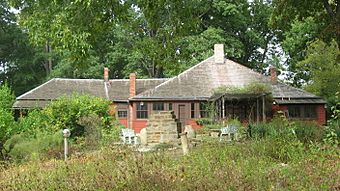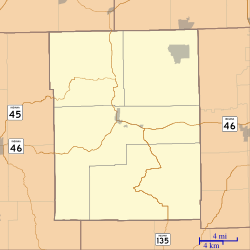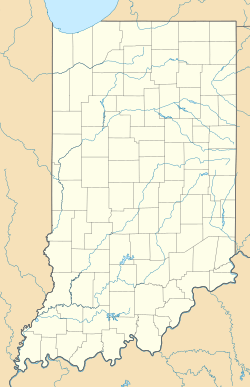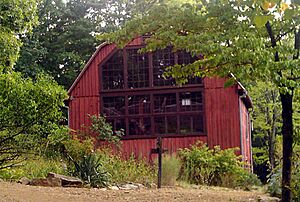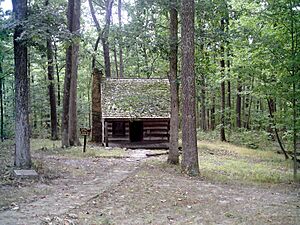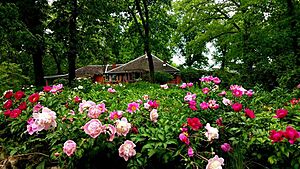T. C. Steele State Historic Site facts for kids
The T. C. Steele State Historic Site is a special place in Brown County, Indiana. It was once the home and art studio of a famous artist named Theodore Clement Steele (1847–1926). His second wife, Selma Neubacher Steele, called their home the "House of the Singing Winds."
This historic site is located near Belmont, between Bloomington and Nashville, Indiana. In 1945, Selma Steele gave the property, which included 211 acres (85 hectares) of land, to the state of Indiana. She wanted to create a historic site to honor her husband. The site was added to the National Register of Historic Places in 1973. Today, the Indiana State Museum runs the site, offering tours of the home and studio to visitors.
The Story of T. C. Steele's Home and Art
Who Was T. C. Steele?
Theodore Clement Steele (1847–1926) was a very important American painter. He was part of a group called the Hoosier Group of impressionist artists. Other famous painters in this group included William Forsyth and J. Ottis Adams.
Steele was born in Owen County, Indiana. He started learning art when he was young. He studied painting in Chicago and Cincinnati before becoming a portrait painter in Indianapolis. He even spent five years studying art in Munich, Germany, from 1880 to 1885. While he painted many portraits, he is most famous for his beautiful landscape paintings.
Steele became a well-known artist across the United States. In 1913, he was chosen as an Associate Artist for the National Academy of Design in New York City. This showed how important he was in the art world. He also received an honorary degree from Indiana University in 1916.
Building a Home and Studio
Around 1905, T. C. Steele was looking for new places to paint. He found a beautiful, quiet area in Brown County, Indiana. In 1907, he bought 60 acres (24 hectares) of land. He then built a home and studio on a hilltop there. Steele and his second wife, Selma, moved into their new summer home in August 1907.
Over time, the Steeles made their property even better. In 1911, they bought more land, making their property 211 acres (85 hectares) in total. They added to their home, created lovely gardens, and built a large studio and art gallery. By 1912, this became their year-round home. Steele also kept an art studio in Indianapolis. Later, starting in 1922, he had a winter home and studio at Indiana University.
After Steele passed away in 1926, Selma and her sister continued to live on the property. Selma worked hard to keep things going. She managed the art studio, rented out cabins, and sold farm goods and her husband's paintings. She even created a small museum in a log cabin on the property, charging a small fee for tours.
In July 1945, Selma gave the Brown County property to the state of Indiana. This gift included the house, its furniture, other buildings, and over 300 of her husband's paintings. She wanted to create a historic site to honor T. C. Steele. The site was officially listed on the National Register of Historic Places in 1973.
Visiting the State Historic Site Today
The T. C. Steele State Historic Site is open to the public from Wednesday to Sunday, 10 a.m. to 5 p.m. Visitors can take guided tours of the home and the large art studio. The 211 acres (85 ha) property has several buildings, beautiful gardens, and five hiking trails. It also includes a nature preserve.
Exploring the Historic Site's Features
The House of the Singing Winds
T. C. and Selma Steele named their home the "House of the Singing Winds." They chose this name because of the breezes that blew through its screened porches. The house was first built in 1907. It was made larger in 1908 to include an art studio in a new west wing. Steele used this studio for seven years.
The house has a unique style with high ceilings, screened porches, and a pyramid-shaped roof. Selma Steele decorated the inside with a mix of styles, including Arts and Crafts. A friend of the family, artist Gustave Baumann, carved a special saying below the fireplace: "Every morning I take off my hat to the beauty of the world."
The Large Art Studio
The big, barn-like studio was built in 1916. Steele often painted outdoors, so this building was mainly used as a gallery. Here, he could show and sell his artworks. The studio is painted a dark red color and measures 30 feet (9.1 m) by 50 feet (15 m). It has a large wall of windows on its north side. Today, the studio still displays many of Steele's paintings.
The Dewar Log Cabin
The Dewar log cabin is a two-story building built around 1875 by Peter Dewar. He was a Scottish immigrant who built it as a wedding gift for his son. In the early 1930s, Selma Steele moved the cabin to her property to save it from being torn down. It became known as the Trailside Museum. In 1934, she dedicated this small museum to her brother, Walter Neubacher.
Other Buildings and Gravesites
The property also has a reconstructed temporary studio that T. C. Steele used in 1911. There were also guest houses built for visitors.
T. C. Steele, his wife Selma, and some of her family members are buried in a family cemetery on the property. It is called the T. C. Steele Memorial Cemetery.
Beautiful Gardens and Nature Trails
The land around the home was not good for farming, but it had "beautiful picturesque woods and hills and valleys" for Steele to paint. Selma Steele took care of the property and helped create its lovely gardens. She planted new trees, shrubs, and many flowers, especially daffodils, which covered the hillsides in spring.
Today, the grounds feature lily ponds, hillside gardens, and a formal garden. There are also five hiking trails to explore: the Trail of Silences, Wildflower Trail, Whippoorwill Haunt Trail, Peckerwood Trail, and Inspiration Ridge Trail. A special area called the Selma Steele Nature Preserve, covering 92 acres (37 hectares), was created within the site in 1990.


